The Burrow

Around the world, many people plan their travel around worldly events – think the FIFA World Cup, or the Olympics.
It makes the stakes a little higher when it comes to ensuring things go as planned. But what happens if they don’t? As travel insurance experts, we’re here to explain how having an adequate level of cover can help you get to your event, even if disruptions occur.
If you have pre-purchased tickets to a large-scale event and you require travel to get there, having a travel insurance policy can be the difference between making it or missing it. If you experience any cancellations or unexpected disruptions that put you at risk of missing your ticketed event, you can take alternative means of transport and be at ease knowing the cost will be covered by your policy, depending on your level of cover.
Of course, each insurer and the policies that they offer are different, so it’s important to check the Product Disclosure Statement (PDS) before purchasing so that you are aware of exactly what you are covered for, including any restrictions or limits that may apply.
One of the most popular worldly events that people around the world travel for every couple of years, is the Olympic Games. For well over 100 years now, the games have been among the elite of sporting events. These events offer a chance for each country to show off their sporting prowess and athletic ability.
And, who can forget: the games also present an opportunity for cities to share their culture and flaunt their showmanship at the opening and closing ceremonies.
But what happens after the lights go down, the medals are awarded and the athletes go home?
We thought we’d take a look at what became of Olympic stadiums around the world from the last 100 years.
| Notes and methodology • We’ve included each Olympic stadium from both Summer and Winter Olympics since 1920 (except for the Youth Olympics) • Some stadiums (e.g. Los Angeles Memorial Coliseum, USA; and Bergiselschanze, Austria) have hosted the Olympics twice. We’ve only included those stadiums once • Olympic stadiums are the ‘main stadium’ of each Olympic Games and where the opening and closing ceremonies were held1 |


Summer Olympics
Where: Melbourne, Australia
When: 1956
As well as being one of Australia’s most famous stadiums, the Melbourne Cricket Ground (MCG) is also the country’s biggest stadium, with a long and rich history dating way back to 1853.2 The MCG has hosted not only the 1956 Summer Olympic Games but also:
What’s more, the ‘G has also hosted a plethora of non-sporting events during its lifetime.
Summer Olympics
Where: Sydney, Australia
When: 2000
The centrepiece of the Sydney 2000 Olympics, Stadium Australia – commercially known as ANZ Stadium – cost AUD$690 million to build and opened in 1999 with a capacity of over 110,000 people.3,4 Since then, the stadium has been reconfigured, with the capacity reducing to just over 83,000.
The stadium now has the facilities to host six different sports: rugby league and union, cricket, American football, AFL and football. As a result, ANZ Stadium has seen some of Australia’s biggest sporting moments including NRL Grand Finals, State of Origins, Bledisloe Cups and Rugby World Cup finals.



Winter Olympics
Where: Innsbruck, Austria
When: 1964, 1976
Bergiselschanze is a ski jump and stadium on the historic Bergisel hill in Austria.5 With a capacity of more than 28,000, Bergiselschanze has had the honour of hosting the Winter Olympics twice: 1964 and 1976.
The stadium was rebuilt in 2001 but still serves as an important sporting venue to this day.
Winter Olympics
Where: Innsbruck, Austria
When: 1964, 1976
Olympiahalle, the other stadium of the 1964 and ’76 Winter Olympics, continues to host all sorts of events from ice hockey to concerts to conventions, and even tennis matches!6


Summer Olympics
Where: Antwerp, Belgium
When: 1920
The Olympisch Stadion was built to host the Summer Olympics in 1920.7 Decades later in 2000, the stadium – which still had running tracks from the 1920 Games – was renovated and transformed into a football stadium. The Olympisch Stadion is now the home of Belgian football club Beerschot.


Winter Olympics
Where: Sarajevo, Bosnia and Herzegovina
When: 1984
Koševo City Stadium was built in 1947. This arena has hosted many sporting events besides the opening ceremony of the 1984 Olympics over the years, including international football matches and athletics championships.8 It has been renovated a few times, including in 1998 to fix damage from the Bosnian War. Around 50,000 people attended the 1984 Olympics opening and closing ceremonies, but today, it has a seating capacity of 37,500 and still plays host to sporting events and concerts.
Winter Olympics
Where: Sarajevo, Bosnia and Herzegovina
When: 1984
Zetra Olympic Hall (now known as Juan Antonio Samaranch Olympic Hall) was built in 1981 to host the closing ceremony of the 1984 Winter Olympics in Sarajevo. Its hosting history also includes many other major ice sporting events.9 The Olympic Hall has also seen a few world speed skating records broken. Like Koševo City Stadium, it was severely damaged in the Bosnian War and was reconstructed from 1997 to 1999.


Summer Olympics
Where: Rio de Janeiro, Brazil
When: 2016
As well as the Olympics in 2016, Maracanã Stadium boasts a long list of sporting events – mostly football – since opening in 1950.10 FIFA World Cups have been played beneath its roof, as well as the World Championships, Confederations Cup and Pan American Games. It’s also played host to musical acts like Paul McCartney, the Rolling Stones and Madonna.


Summer Olympics
Where: Montreal, Canada
When: 1976
Built for the 1976 Olympic Games in Montreal, the Olympic Stadium was initially budgeted to cost CA$134 million to build but had grown to a staggering CA$1.4 billion by the time the costs were paid off in 2006.11 The overall cost of the whole Olympic Park in Montreal totalled CA$5.2 billion (when indexed to the 2017 consumer price index)!12
During its lifetime, Olympic Stadium has seen around 66 million visitors fill its seats.13 The stadium has also hosted sports like baseball and soccer, as well as shows, exhibitions and concerts.

Winter Olympics
Where: Calgary, Canada
When: 1988
McMahon Stadium was built in 1960 and already had a long, rich sporting history as the home of the Calgary Stampeders before the Winter Olympics opening and closing ceremonies took place there in 1988.14 Aside from the Olympics and football games, McMahon Stadium has also hosted a range of sporting events and concerts.
Winter Olympics
Where: Vancouver, Canada
When: 2010
Opened in 1983, BC Place Stadium has hosted more than just the 2010 Winter Olympics.15 Its long list of credentials includes the FIFA World Cup qualifying matches, the Women’s World Cup Championship Final in 2015, Canada Sevens games, Grey Cup Championships and concerts from the likes of Metallica, U2, Taylor Swift and Coldplay.


Summer Olympics
Where: Beijing, China
When: 2008
Constructed specifically for the 2008 Olympics, Beijing National Stadium, also known as the ‘Bird’s Nest’, covers an area of about 63 acres and can seat 80,000 people.16 It cost nearly CN¥2.3 billion to build (equivalent to USD$427 million in today’s money!). The uniquely designed stadium is still used for both domestic and international sporting events today, and is due to host the 2022 Winter Olympics.



Summer Olympics
Where: Helsinki, Finland
When: 1952
Helsinki’s Olympiastadion was built in 1938 and served as the stadium for the 1952 Summer Olympics in Finland.17 Today, the stadium still hosts all sorts of events (including sports and concerts). After being closed for renovations for some time, the stadium reopened in August 2020.



Winter Olympics
Where: Chamonix, France
When: 1924
The Olympic stadium in Chamonix is an equestrian stadium opened in 1923.18 It was the venue for the opening and closing ceremonies of the 1924 Olympics, as well as for various ice and snow sports
Summer Olympics
Where: Colombes, Paris, France
When: 1924
The 1924 Summer Olympics was held at Stade Olympique Yves-du-Manoir (also called the ‘Stade Olympique de Colombes’) in the Parisian commune of Colombes.19 Since its beginnings in 1883, the stadium has hosted not only the Olympics but also some of football’s biggest events, like the World Cup and European Cup. It’s also home to the French rugby union club Racing 92.

Winter Olympics
Where: Grenoble, France
When: 1968
Stade Olympique was built solely to host the opening ceremony of the 1968 Winter Olympics; after the games, it was disassembled.20
Winter Olympics
Where: Grenoble, France
When: 1968
Officially opened in 1967, the Palais des Sports (then known as Stade de Glace) hosted the closing ceremony of the 1968 Games.21
Winter Olympics
Where: Albertville, France
When: 1992
The Théâtre des Cérémonies was built specifically to host the opening and closing ceremonies of the 1992 Winter Olympics in Albertville.22 It was taken down after the games and parts were sent to Barcelona for the Summer Olympics that same year.


Winter Olympics
Where: Garmisch-Partenkirchen, Germany
When: 1936
The Olympic Ski Jump on the Gudiberg hill in Germany was originally built in 1923.23 It’s still used as such today but was rebuilt in 2007; the start tower is now 100 metres tall!

Summer Olympics
Where: Berlin, Germany
When: 1936
Built for the 1936 Summer Games (and costing 42 million Reichsmark in the process, equivalent to more than €308 million today!),24 the Olympiastadion could seat a staggering 100,000 people.25 After the games, the stadium continued to see sporting and even military action when, during World War II, it was used as a bunker and storage facility.
After receiving a facelift in the early 2000s, the stadium was welcomed back with a reopening ceremony. It now plays hosts to major sporting events and concerts from the likes of Madonna, Coldplay and the Rolling Stones.
Summer Olympics
Where: Munich, Germany
When: 1972
The 1972 Summer Olympics was held in Munich, Germany, with Olympiastadion serving as the venue for the opening and closing ceremonies, as well as other Olympic events.26 The stadium also hosted the World Cup final only two years later.
Aside from sport, Olympiastadion has also seen its fair share of cultural events, including concerts from music megastars like Elton John, the Rolling Stones and AC/DC.



Summer Olympics
Where: Athens, Greece
When: 2004
The Olympics returned to its ancient home in 2004 for the Summer Games in Athens.27 Athens’ Olympic Stadium – originally constructed in 1982 – was used as the stadium for the games and had a roof added to it in 2004 in preparation for them. Today, it houses a football field, running tracks, shot put circles, javelin lanes and other athletic facilities.


Winter Olympics
Where: Cortina d’Ampezzo, Italy
When: 1956
This ice-rink-turned-stadium at the heart of the 1956 Winter Olympic Games (also the first to be broadcast on live television) still stands today. The stadium even still houses the same brazier where the Olympic Flame burned all those years ago!28 Today, it’s a public ice rink open all year round.
Summer Olympics
Where: Rome, Italy
When: 1960
Officially opening in 1953, the Stadio Olimpico in Rome, Italy was originally called Stadio dei Centomila before a name change ahead of the 1960 Olympic Games.29 Like several of the great sporting stadiums before it, Stadio Olimpico has hosted more than just an Olympics, including:
Winter Olympics
Where: Turin, Italy
When: 2006
Turin’s Olympic Stadium was originally opened in 1933.30 Aside from its stint as the main stadium for the 2006 Winter Olympics, Stadio Olimpico has a long history as a football stadium and was converted back to this function after the Olympics and Paralympics finished.



Summer Olympics
Where: Tokyo, Japan
When: 1964
Tokyo’s National Stadium hosted the first Olympics in Asia in 1964.31
The stadium hosted many more significant sporting events, like the Asian Games and World Athletics Championships.32 However, in preparation for the 2020 Olympics in Tokyo, the decision was made to demolish it and rebuild the New National Stadium on the same site, ready for use at the next games.31

Winter Olympics
Where: Sapporo, Japan
When: 1972
The Makomanai Open Stadium opened in 1971, the year before it hosted the opening ceremony of the 1972 Summer Olympics in Sapporo.33 It’s still in use to this day and boasts tennis and futsal courts, an outdoor skating rink, training rooms and a range of fitness and sports classes.

Winter Olympics
Where: Sapporo, Japan
When: 1972
Opened in 1970, the Makomanai Ice Arena hosted the closing ceremony of the 1972 Olympics, as well as the figure skating and ice hockey events.34 With a capacity of 11,500 people, the ice arena is now a community ice skating rink as well as a venue for meetings and concerts.
Winter Olympics
Where: Nagano, Japan
When: 1998
Home of the 1998 Winter Olympics, the Nagano Olympic Stadium now houses a baseball field and training facilities. It has a capacity of 35,000 and holds baseball matches on the weekends from March through to November every year. 35
Summer Olympics
Where: Tokyo, Japan
When: 2020
Officially opened in 2019, Japan National Stadium (also known as New National Stadium) sits on the site of the original National Stadium used for the 1964 Olympics in Tokyo.36 The new stadium cost nearly JP¥157 billion to build, equivalent to nearly USD$1.2 billion.37 After the 2020 Olympics (now being held in 2021) are over, the stadium will host a mix of sport and cultural events.36


Summer Olympics
Where: Mexico City, Mexico
When: 1968
Mexico’s Olímpico Universitario was built in 1952 and hosted several major sporting events (like the Pan American Games) before it came time for the stadium to host the 1968 Olympic Games.38 Olympic events that took place there include the opening and closing ceremonies, track and field events, some football matches, athletics and equestrian events. The stadium also hosted some FIFA World Cup games in 1986.



Summer Olympics
Where: Amsterdam, Netherlands
When: 1928
Originally built for the 1928 Summer Olympics, the Olympisch Stadion in Amsterdam has since continued to host an array of sporting events. It was even home to the football club AFC Ajax until 1996.39
The building was destined for demolition in the mid-late 1990s until it was declared a national monument.40 After it was saved from the scrap pile, the stadium was renovated back to the track and field venue that it was originally built to be.39


Winter Olympics
Where: Oslo, Norway
When: 1952
As one of Norway’s major sporting arenas, Bislett Stadion has hosted more than just the 1952 Winter Olympics. This stadium alone has seen more than 50 world records in athletics and nearly 20 speedskating records.41 The original stadium that stood during the 1952 Olympics (and cost €55 million to build!42) was demolished in 2004 to make way for the current one standing in its place.

Winter Olympics
Where: Lillehammer, Norway
When: 1994
Constructed in 1992, Lysgårdsbakken is a ski jump facility that hosted the 1994 Winter Olympics.43 It was also the home of the ski jumping World Cup and the 2016 Youth Olympics. A renovation in 2007 brought the stadium up to code, and still to this day it sees around 100,000 jumpers fly down its slopes every year.


Summer Olympics
Where: Moscow, Russia
When: 1980
Moscow’s Luzhniki Stadium was first opened in 1956 and used for football and athletics events until it hosted the 1980 Olympics.44 Afterwards, it continued to host major sporting events, some recent ones including the UEFA Champions League Final in 2008, the 2013 IAAF World Athletics Championships and the 2018 World Cup Final. Extensive renovations have been made to Luzhniki Stadium over the years, including in the lead-up to the 1980 Olympics.
Winter Olympics
Where: Sochi, Russia
When: 2014
Fisht Stadium was built specifically to be the centrepiece of the 2014 Winter Olympic Games in Sochi, and cost around RUB₽23.5 billion (or nearly USD$478 million in today’s money) to build.45,46 Since then, it’s hosted an array of football events, including one of the most important of all: the FIFA World Cup, which the stadium hosted in 2018.



Summer Olympics
Where: Seoul, South Korea
When: 1988
Construction began on Seoul Olympic Stadium (also known as Jamsil Olympic Stadium) in 1977 when the stadium was originally intended to host the Asian Games in 1986.47 The stadium was awarded the 1988 Olympics as well.
The arena has since hosted mainly football matches, as well as a long line of musical acts from around the world.
Winter Olympics
Where: Pyeongchang, South Korea
When: 2018
Pyeongchang’s Olympic Stadium was specifically built (at a cost of USD$109 million)48 to host the opening and closing ceremonies of the 2018 Winter Olympics – and it was built to be demolished and recycled after the games were finished.49 In 2019, the South Korean government announced plans to build a memorial hall on the site of the former stadium.50


Summer Olympics
Where: Barcelona, Spain
When: 1992
Barcelona’s Olympic Stadium was first opened in 1929.51 Back then, it was the second-largest stadium in the world. However, it wasn’t in use for long before it fell into disrepair. The stadium was reconstructed in preparation for the 1992 Summer Olympic Games and opened in 1989. Nowadays, it has a capacity of 60,000 people and has hosted all sorts of sporting, cultural and corporate events.


Winter Olympics
Where: St. Moritz, Switzerland
When: 1928, 1948
The stadium hosted the first official Winter Olympic Games in 1928 (the 1924 Games in Chamonix wasn’t given the official title at the time).52 It again hosted the Winter Olympics in 1948.
The stadium still stands today, but it had been more or less abandoned for a couple of decades until designer Rolf Sachs restored it – before moving in!


Summer Olympics
Where: London, UK
When: 1948
The famous Wembley Stadium opened in 1923 and played host to major sporting events before it was chosen as the stadium for the 1948 Summer Olympics.53 In 2003, the stadium that had stood since 1923 was demolished to make way for a new one, which still sits on the same site and bears the same name.

Summer Olympics
Where: London, UK
When: 2012
London Stadium – originally called ‘Olympic Stadium’ – was purpose-built for the 2012 Olympics (costing £486 million in the process)54 and is now home to West Ham United and UK Athletics.55 It has a capacity of 60,000 during football events, and is often expanded to 80,000 for concerts. Sports played at London Stadium include the Rugby World Cup, Major League Baseball, Rugby Union and the RFL Four Nations.


Winter Olympics
Where: Lake Placid, USA
When: 1932
The Olympic Skating Rink opened in 1932 in Lake Placid, USA for that year’s Winter Olympics.56 As well as being the main stadium for the 1932 Olympics, it also hosted speed skating events. The stadium hosted those events again during the 1980 Olympics in Lake Placid, however it wasn’t the main stadium.
Summer Olympics
Where: Los Angeles, USA
When: 1932, 1984
The Memorial Coliseum in Los Angeles has a long and rich history of hosting a variety of events since its construction in 1923. As well as the 1932 and ’84 Summer Olympics, the nearly-century-old stadium has also:57

Winter Olympics
Where: Squaw Valley, USA
When: 1960
The Blyth Memorial Arena in Squaw Valley was opened in 1959 to host the 1960 Winter Olympic Games.58 It had a seating capacity of 8,500 and played host to the opening and closing ceremonies, ice hockey and ice skating during the games. Blyth Memorial Arena was demolished in 1983.
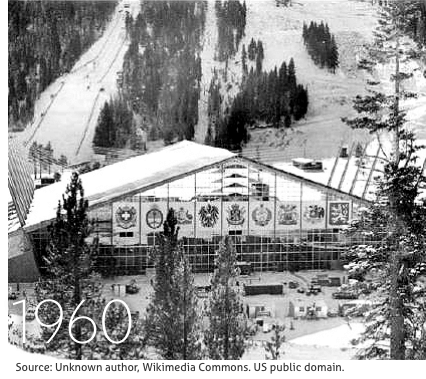
Winter Olympics
Where: Lake Placid, USA
When: 1980
The opening ceremony of the 1980 Olympics in Lake Placid was held in a temporary stadium built next to the existing Lake Placid Equestrian Stadium.59
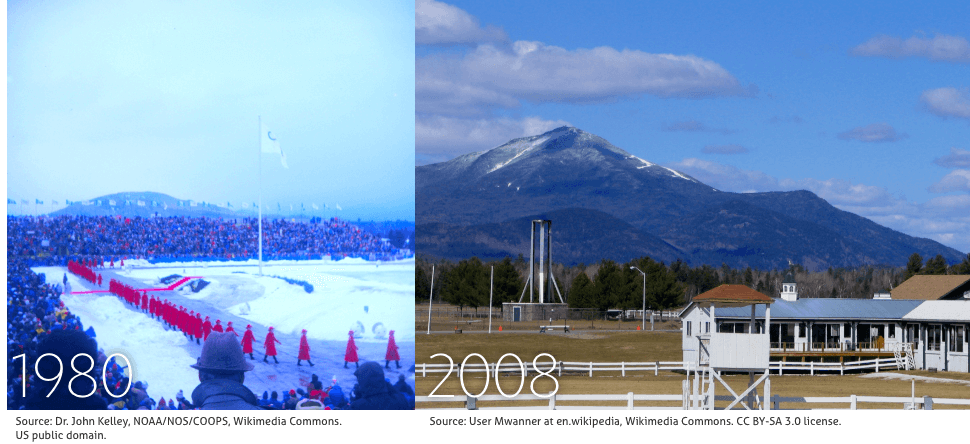
Winter Olympics
Where: Lake Placid, USA
When: 1980
Herb Brooks Arena still stands today and, as well as the 1980 Olympics, has hosted a range of sporting events, including ECAC Hockey Championships, figure skating competitions and USA Hockey events.60
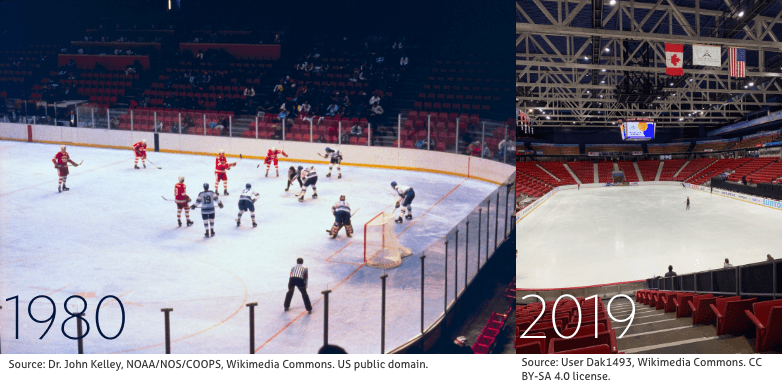
Summer Olympics
Where: Atlanta, USA
When: 1996
Costing USD$207 million to build, the Centennial Olympic Stadium in Atlanta opened in 1996 for the Summer Olympic Games.61,62 In 1997, after the conclusion of the games, the stadium was bought by the Atlanta Braves baseball team, converted into a baseball stadium and renamed Turner Field.
Twenty years later, the stadium was reconstructed once more by Georgia State University. Today, it’s known as Georgia State Stadium and hosts American football games, graduations and concerts for the university.

Winter Olympics
Where: Salt Lake City, USA
When: 2002
The Rice-Eccles Stadium has technically stood since 1927, but was almost entirely demolished in 1997 to be rebuilt (at a cost of USD$50 million) for the 2002 Winter Olympics in Salt Lake City.63 Since hosting the Olympics, the stadium has continued to host American football games (as it did before the Olympics).
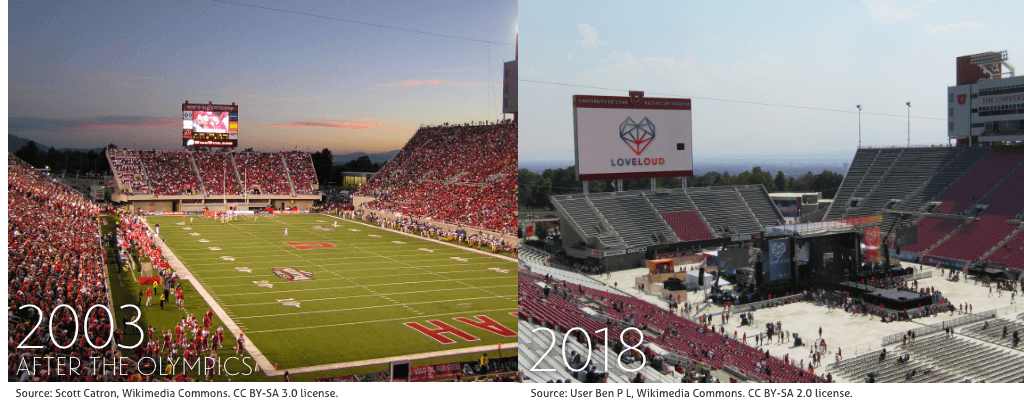

Brought to you by Compare the Market: Making it easier for Australians to compare Travel Insurance.